Texturizers Build Better Food Products
INGREDIENTS
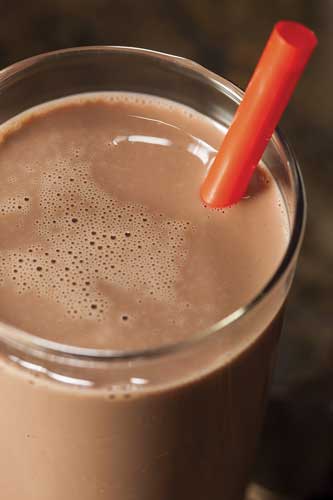 The interest and attention given to texture during product development plays a vital role in the overall eating and drinking experience,” says Donna Klockeman, senior principal food scientist at TIC Gums, White Marsh, Md. (ticgums.com). Texture has always been an important consideration during product development. It often determines a consumer’s first impression and offers a lasting impression of foods and beverages, remarks Andrea Peck Moeller, senior technical specialist, texturizing group, at Cargill, Minneapolis, Minn. (cargill.com).
The interest and attention given to texture during product development plays a vital role in the overall eating and drinking experience,” says Donna Klockeman, senior principal food scientist at TIC Gums, White Marsh, Md. (ticgums.com). Texture has always been an important consideration during product development. It often determines a consumer’s first impression and offers a lasting impression of foods and beverages, remarks Andrea Peck Moeller, senior technical specialist, texturizing group, at Cargill, Minneapolis, Minn. (cargill.com).
Now more than ever, food manufacturers are emphasizing texture messaging on food packaging to entice consumers to buy their products. Data from Innova Market Insights shows a significant increase in front-of-package texture claims between 2011 and 2015 in markets including Europe, the Middle East, Latin America, and North America (Figure 1). Food companies are using creative language to communicate the texture message. Some of the terms Innova Market Insights tracked include “crunchy,” “creamy,” “thinly cut,” “smooth,” “crispy,” “super moist,” “ooey gooey chocolatey chewy,” and “oh so creamy.”
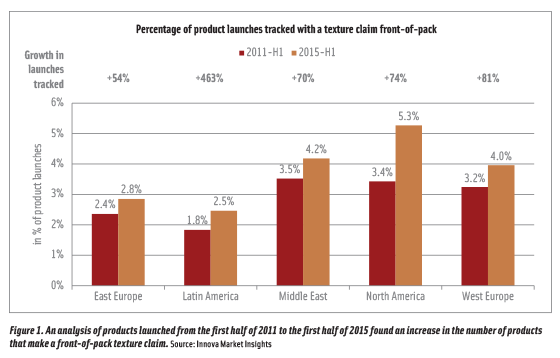 Ingredient advances continue to improve the crunchiness of chips, the chewiness of soft candies, the creaminess of sour cream, and much more, allowing for the formulation of a wide array of products that consumers crave. Starches, gums, and emulsifiers play specific roles in developing and enhancing textures of all sorts—crunchy, crispy, chewy, gummy, thick, and creamy. In addition to this, many of these same ingredients help food and beverage products survive the rigors of processing, transport, and storage by creating structure, reducing syneresis, providing freeze/thaw stability, suspending ingredients in solution, and preventing foods from drying out, to name a few.
Ingredient advances continue to improve the crunchiness of chips, the chewiness of soft candies, the creaminess of sour cream, and much more, allowing for the formulation of a wide array of products that consumers crave. Starches, gums, and emulsifiers play specific roles in developing and enhancing textures of all sorts—crunchy, crispy, chewy, gummy, thick, and creamy. In addition to this, many of these same ingredients help food and beverage products survive the rigors of processing, transport, and storage by creating structure, reducing syneresis, providing freeze/thaw stability, suspending ingredients in solution, and preventing foods from drying out, to name a few.
Texture Knowledge Fuels Innovation
“Texture and its perception is really quite complex,” says Moeller. Texture perception occurs when the food is placed in the mouth, but that is not the only way. Texture is actually perceived with all of our senses. Moeller points out that you can often tell if a product is dry, moist, tender, etc., just by looking at it. How a product sounds also plays a role in texture perception, she adds. Most important, though, is that whatever texture experience food manufacturers create, it has to remain consistent over shelf life, she says.
Making simple changes to product texture can be more impactful than you think. For example, formulators can turn a single product into a platform that appeals to a wide range of consumers, says Klockeman. There are two advantages to this. One is that it is an easier approach than developing products from scratch, and the other is that it can be brought through the development process more quickly.
“In dairy, for instance, there can be an untapped opportunity to diversify consumer appeal of traditional dairy products,” explains Klockeman. “Take flavored milk as an example. Company X already produces traditional flavored milk (chocolate, most likely). A slight change in texture (lower mouth coating, higher mouth clearing, and reduced cohesiveness) combined with a refreshing flavor (banana and vanilla) makes it appealing as an exercise recovery beverage. An increase in mouth coating, decrease in mouth clearing, and a more indulgent flavor profile (chocolate truffle fudge) and you have a dessert alternative for adults.”
To develop a targeted texture, product developers need to determine what attributes are responsible for the perceived mouthfeel of a product, says Klockeman. TIC Gums scientists use the company’s comprehensive list of textural attributes and descriptors called the Texture Lexicon to help product developers assess the textural components of foods and beverages. “The lexicon translates consumer terms such as ‘creamy’ into basic texture attributes like mouth coating, viscosity, and awareness of particulates,” she says. “With these basic texture attributes established, specific texture and stability can be addressed with various hydrocolloid solutions.”
Moeller has expertise in working with a number of texturizing ingredients, from starches to soy proteins. Currently, her projects include developing texture solutions in fruit beverages and confections using Cargill’s line of hydrocolloids (alginates, pectin, xanthan gum, carrageenan, and galactomannans). She and her colleagues often show customers how switching out starches with these different hydrocolloids can produce a range of textures. Pectin can provide a cleaner bite and clarity of flavor while carrageenan adds some chewiness to certain types of candy, she says.
Textures that are indulgent, crunchy, and chewy are among the overarching global texture trends that Moeller notes. There is also an interest in layering textures. Texture preferences definitely differ from one market to another, says Karen Silagyi, product manager at TIC Gums. “There are some textures that exist only in certain types of cuisine, and it can be difficult for a person who has never tried this type of food to understand the sensory experience of the foreign texture,” says Silagyi. “In other instances, foods that are found globally will have various textures based on their region.”
--- PAGE BREAK ---
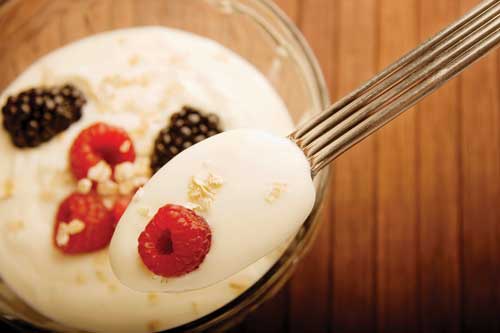 Silagyi points to yogurt as an example. Yogurt can be found in many global cuisines, but its texture varies widely. Differences in viscosity, heaviness, firmness, aeration, and sheen/shine contribute to regional textures, and by analyzing these attributes, yogurt product developers are more effective at understanding and developing products for various global markets, she says. Product developers can create different textures in products by varying the usage levels of many of TIC Gums’ ingredients. Making simple adjustments to the usage level of Dairyblend YG AG, she adds, can produce a drinkable-style yogurt or a thick spoonable yogurt popular in different parts of the world.
Silagyi points to yogurt as an example. Yogurt can be found in many global cuisines, but its texture varies widely. Differences in viscosity, heaviness, firmness, aeration, and sheen/shine contribute to regional textures, and by analyzing these attributes, yogurt product developers are more effective at understanding and developing products for various global markets, she says. Product developers can create different textures in products by varying the usage levels of many of TIC Gums’ ingredients. Making simple adjustments to the usage level of Dairyblend YG AG, she adds, can produce a drinkable-style yogurt or a thick spoonable yogurt popular in different parts of the world.
Moeller, too, addresses the regional differences in texture preferences in such a popular product as yogurt. Indulgent textures are especially important in dairy applications sold in the United States, where consumers expect creamy textures. Yogurt sold in this market, for example, is starchy with a thicker mouthfeel, says Moeller. Consumers in many Asian countries, on the other hand, prefer yogurt that has a very thin consistency, almost drinkable. Europeans prefer full-fat yogurt with a slightly thin consistency. Fat-reduced yogurt, however, has become quite popular in the overall dairy health and wellness segment in Europe, notes Denis Palacioglu, EMEA starch product manager at Cargill, in a press statement (Cargill 2015). In November, the company released C CreamTex 06329 modified starch that allows for a minimum fat reduction of 50% with little impact on the taste and mouthfeel of yogurt. The company reports that its new stabilized n-octenylsuccinylated starch can improve creaminess, mouth thickness, and shine that is lost when fat is replaced with hydroxypropyl starches.
Some of the recent ingredients that TIC Gums has developed include hydrocolloid blends that help improve the texture and stability of ready-to-drink protein beverages. Ticaloid Pro HC 932 suspends protein and vitamin/mineral blends in higher protein beverages without affecting the viscosity, explains Dan Grazaitis, senior food technologist at TIC Gums. In lower protein beverages, Ticaloid Pro HC 910 suspends protein and other fortifying ingredients and also increases the viscosity and heaviness to produce an indulgent drink that is not watery or gritty, he adds.
 Influencing the Eating Experience
Influencing the Eating Experience
“Ingredion understands that texture is a multi-dimensional part of the entire eating experience that plays a huge role in consumer product choices and enjoyment,” says Marcelo Nichi, senior manager, marketing–texture North America at Ingredion, Westchester, Ill. (ingredion.us). “Crispness, crunchiness, creaminess, chewiness—these are all aspects of the eating experience that we can influence with our texturizers, plus applications and formulation knowledge.”
The Ingredion scientists know that consumers have definite texture preferences for food, but little is actually known about what drives these preferences, says Mary Lynne Shafer, director, global marketing–texture at Ingredion. “Texture understanding lags behind that of flavor because people generally have low texture awareness and limited ability to verbalize textural characteristics.” One way that texture experts can gain a better understanding is to examine the eating experience through consumer mouth behaviors, Shafer explains. She begins by pointing out that Americans can be classified by eating styles: chewers (43%), crunchers (33%), smooshers (16%), and suckers (8%). “Through this research, we know that a distinctive crunch means ‘fresh’ to a cruncher, and decadent creaminess feels like ‘comfort’ to a smoosher. Working with our team, you will use insights like these to target your products and line extensions to the exact way your consumers prefer to eat,” says Shafer.
As the scientists learn more about texture preferences and what drives these preferences, they develop new ingredients or make improvements to existing ones—all to bring new textural enhancements to food and beverage products around the world. Products like snack foods, for instance. “Consumers everywhere are enjoying snacks—from tender, delicate crispy textures to snapping or shattering crunchy textures and in between to a new region we call ‘crinchy’ textures,” says Nichi. Cheese, too, is another product category popular with consumers in many global markets. Like snack products, cheese comes in a variety of textures. Other qualities of cheese are important too, such as melting characteristics and how easily it shreds. “In 40%-casein-reduced imitation mozzarella cheese, for example, PRECISA 600 systems and GEL ‘N’ MELT starch can help you achieve good firmness, shreddability, and stretchability for pizza and other cheese applications,” explains Nichi. “At the same time, PRECISA 600 series solutions deliver the emulsification and water-holding capacity you need to achieve process efficiencies and reduce product defects.” The final category Nichi mentions is beverages. “As the exclusive distributor for Gelymar in North America, we are helping customers use our PRECISA carrageenan solutions to achieve unique textures in beverages,” says Nichi. He even offered a preview of a development in the works by the company’s scientists. “Our experts are also innovating to put a new twist on alcoholic beverages—a segment poised for growth in many regions.”
While the company offers a number of different types of ingredients for texture improvements and enhancements, starches are still the most popular. “Starches are the backbone of Ingredion’s texture portfolio, and they have a key role in building back texture if fat, sugar, or calories are removed, transforming the texture into a whole new eating experience or simply cleaning up the label,” says Nichi. And, he adds, starches are the most versatile and affordable texturizers available.
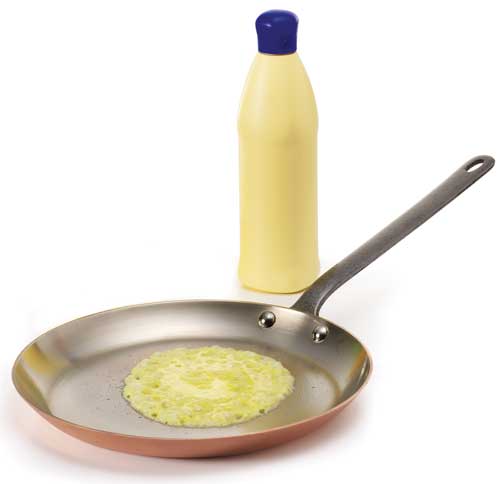 Emulsifiers for Margarine, Chocolate Debut
Emulsifiers for Margarine, Chocolate Debut
As a global emulsifier specialist, Palsgaard, Juelsminde, Denmark (palsgaard.com), pulled out all the stops at the 2015 Food Ingredients Europe (FIE) show, where it had experts on hand to highlight the company’s latest emulsifier developments for a range of applications.
One of the ingredient categories that the company has deep roots in is margarine emulsifiers. The company’s founder invented margarine production methods in the 1800s, and scientists developed the first commercial emulsifier for margarine in 1917. Since that time, Palsgaard has made available more than 100 different ingredients for margarine; they function in frying margarines, table margarines, spreads, bakery margarines, and shortening. The newest ingredient launched at the show is Palsgaard 3324 emulsifier blend for liquid margarine. It is a combination of mono-diglycerides of vegetable fatty acids and citric acid esters of vegetable fatty acids. Combining the qualities of these two gives Palsgaard 3324 emulsifying and crystallizing properties for liquid margarine as well as excellent frying and anti-spattering results in frying applications and anti-staling effects in dough systems, explains Anders Mølbak Jensen, product and application manager for lipids and fine foods, in a company press statement (Palsgaard 2015).
--- PAGE BREAK ---
For chocolate manufacturers, Palsgaard introduced Palsgaard AMP 4455, an ammonium phosphatide, as an alternative to lecithin. It is produced from a combination of refined and deodorized sunflower oil and glycerin. The company focuses on several benefits the ingredient can offer to manufacturers such as viscosity control and cost savings. Using as little as 40% of the dosage normally required with lecithin reduced the plastic viscosity and yield value of chocolate. As far as cost is concerned, the company has shown that using lecithin in chocolate at a dosage of around 0.4% provides cocoa butter or vegetable fat savings of about 4% whereas using AMP 4455 can extend these savings by an additional 2%–3%. In addition to these benefits, the ingredient also has a neutral taste and odor in chocolate, including chocolate with low content of cocoa solids, white chocolate, and white confectionery spreads.
Palsgaard invented and patented the activated cake emulsifier more than 30 years ago and since then it has developed a range of activated cake emulsifiers that help improve the stability and quality of cake. FIE attendees had the chance to pick up samples of a sugar-free and gluten-free devil’s food cake mix, a new formulation that the company promised will produce a cake that is moist, has a stable structure, and no trans fat. The mix is formulated with Emulpals 110, a blend of polyglycerol esters, monoglycerides, and diglycerides that it combined with rice starch in an extrusion process to produce a free-flowing, off-white powder. The ingredient has shelf life of a minimum of 24 months and has high tolerance to ingredients like egg powder, cocoa, and oil.
In addition to focusing on emulsifiers for these three areas, the company also presented ingredient solutions for mayonnaises and dressings, dairy products like yogurt and flavored milk, and ice cream. The emulsifiers and stabilizer systems (gums and modified starches) provide improvements to the mouthfeel, viscosity, and stability of products.
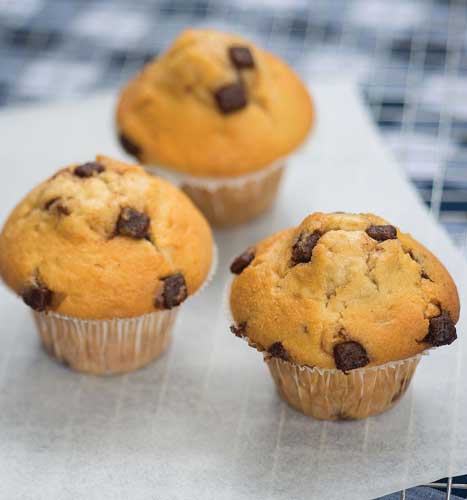 Ingredients Target Stability Challenges
Ingredients Target Stability Challenges
Each product category has specific issues to overcome when it comes to texture and stability. A menu of culinary-inspired product concepts presented at the FIE show demonstrated the functionalities of texturizers and stabilizers from ICL Food Specialties, St. Louis, Mo. (iclfood.com). Most of the ingredients presented at the show, which was held in Paris, are available to customers in Europe.
Ingredients in the BEKAPLUS line of stabilizers based on hydrocolloid blends, agglomerated hydrocolloid phosphate blends, and others provided stabilization control, texture enhancement, moisture control, and improved process tolerance in four product concepts. BEKAPLUS BP 1210 stabilized dairy proteins during heat processing in a high-protein, low-fat ultra-high-temperature (UHT) dairy beverage product concept. Another high-protein beverage featured BEKAPLUS BP 900, a whey protein for acidic applications with neutral taste. The ingredient is soluble in cold water and has high stability during pasteurization and UHT processing. BEKAPLUS DP 302, a ready-to-use protein-based emulsifier system, and BEKAPLUS BP 751 stabilizer gave a creamy, consistent texture to a jalapeño dip and grapefruit liqueur, respectively. In addition to providing a creamy texture to the liqueur, BEKAPLUS BP 751 can help to increase the product’s shelf life under ambient storage conditions.
Vegetarian versions of meat products need some type of ingredient or combination of ingredients to bind everything in the formulation together and create desired texture. In many cases, product developers will use soy protein as a texturizer, but other plant-based proteins are being used as well. ROVITARIS is made from non-soy vegetable proteins that help to develop texture in vegetarian food and add to the overall protein content of the finished products. The ingredient was formulated into a vegetarian hot dog. Germany-based Rovita, which was acquired by ICL Food Specialties in early 2015, offers the ingredient.
Finally, in the spirit of being in France, the ICL food technologists developed a twist on the traditional gougère, a baked savory choux pastry made with cheese, by developing a cake pop version stuffed with a spicy cream filling. This version was formulated without eggs, so that’s where BEKABAKE EF2 came in. The calcium-phosphate ingredient functioned as a dough conditioner to help stabilize the gluten network to provide the volume and density that eggs would otherwise help develop. The ingredient also functioned in a similar way in an egg-free chocolate cashew muffin, where it helped to produce a soft and tender crumb. When used with an optimized chemical leavening system, BEKABAKE EF2 produces uniform cell size and distribution in baked goods. Adjusting the leavener in this case allows the food manufacturer to maximize volume and tailor the formulation by application, according to the company.
 Keeping Crust Crispy
Keeping Crust Crispy
The perfect piece of fried chicken is crispy and crunchy on the outside and juicy on the inside. When the batter or breading fails to fully adhere to the chicken before or during frying, a proper crust does not form, allowing the migration of moisture that affects the texture of both the chicken and crust. The result: dry chicken and soggy crust that just won’t cut it for consumers.
Advanced Food Systems, Somerset, N.J. (afsnj.com), manufactures customized ingredient systems from emulsifiers, gums and other hydrocolloids, starches, and more to help prevent breading fall-off on fried chicken and other fried products like beef and pork cutlets, chicken nuggets and patties, fish and other seafood, and vegetables like onions, eggplant, and pickles. Its latest ingredient system, Seal N’ Crisp CAS (Crispy Adhesion System), works with the water on food to create what is essentially a barrier to keep moisture below the layer of breading, allowing a crisp coating to develop. The company has demonstrated the ingredient’s functionality at maintaining crispiness in fried foods that are microwaved from frozen, reheated in a microwave, or kept under heat lamps. It even has shown success at helping crusts keep their texture upon cooling during transport in take-out applications.
--- PAGE BREAK ---
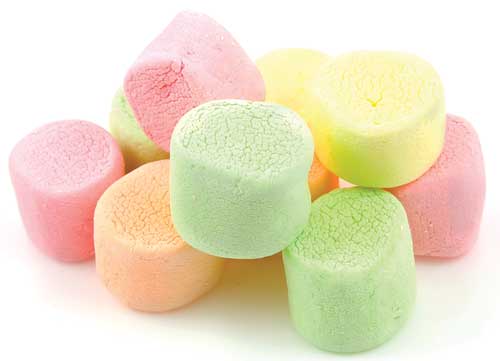 Enhancing Confections with Gelatin Systems
Enhancing Confections with Gelatin Systems
The Synergy Systems line from Rousselot, Son, the Netherlands (rousselot.com), consists of four ingredient systems, each designed to bring functionalities to specific applications. The first three are combinations of a particular type of gelatin (porcine or bovine) and pectin for use in confectionery products. AcidoGel gelling and foaming agent is specifically formulated for use in acid marshmallows. These are marshmallows made with “extreme” acid flavors like sour. Gelatin on its own may not develop flavor release and stability in acid marshmallows. AcidoGel, however, has demonstrated functionalities like flavor release and developing fluffy textures in confectionery at low pH (3.2–3.4). ResistaGel-P helps produce stable aerated and non-aerated low-pH confections like gummies in warm climates. NeutralGel-B stabilizes aerated and non-aerated textures at neutral pH in sweet and savory applications. The company points out that the ingredient is particularly useful in marshmallows and gum-like snacks that feature savory flavors such as wasabi, cheese, and bacon. Here, the ingredient allows for good flavor release, something that can be difficult in sugar confectionery formulated with such flavors.
The fourth ingredient in the line, this one a blend of gelatins, is EmulsiGel. The ingredient functions as an emulsifier and stabilizer and can replace lecithin, monoglyceride and diglyceride esters, and egg yolk. This mix of gelatins is suited for use in oil-in-water emulsions such as sauces, dressings, and spreads, and in meat applications.
Next month’s Ingredients section will feature ingredients used to formulate pet food.
Crunch n’ Munch
Bring up snack food products and you think of crackers, cookies, chips, and bars. Each one of these snack foods has its own characteristic texture—from a light and delicate crisp to a hard crunch. Starches from Tate & Lyle, Hoffman Estates, Ill. (tateandlyle.com), allow manufacturers to develop crunch, crackle, and other related textures to enhance the eating experience of snack foods. Various instant and cook-up starches from the company’s starch ingredient offerings (native, pregelatinized, cold-water swelling, lipophilic, instant, and cook-up) perform different texture functions for the various snack food categories. Some include increasing expansion of extruded snacks like cheese puffs and extruded breakfast cereal while others can be used to develop crunchy coatings for fruits and nuts. The company also promotes the texture- and stability-enhancing properties that are important during the processing of products before they even reach the consumer. For instance, starches contribute to the dough cohesion that makes dough sheets pliable and moderately elastic without ripping or tearing during sheeting, and they also help reduce the absorption of fat during frying without affecting the texture of the chip.
Solution for Gluten Replacement
Gluten contributes important structural functions to bakery applications. When gluten is mixed with water, it forms elastic, cross-linked molecules that give elasticity to bread dough, cause the dough to rise, and give the finished product a chewy texture. Without it, the product will not develop the proper volume and will have a tough texture. At the 2015 Food Ingredients Europe show, Ashland Specialty Ingredients, Wilmington, Del. (ashland.com/food-beverage), promoted its Benecel hydroxypropyl methylcellulose (HPMC) modified cellulose as a replacement for gluten in gluten-free baked goods. The company explains that modified cellulose has been shown to improve bread loaf volume, texture (particularly softness of bread), and crumb structure in gluten-free baked goods. This ingredient, as well as Benecel methylcellulose modified cellulose, has a different polymeric structure from other cellulosics, which improves the texture and mouthfeel of products.
Ingredient Roundup
Looking for more ingredients that improve the texture of and provide stability for foods and beverages? Consider the following options for improvements and enhancements.
• The Keystone line of stabilizer systems from Agropur Ingredients, La Crosse, Wis. (agropuringredients.com), provides specific functionalities to ice cream and frozen desserts, processed cheese, dry-mix beverages, baked goods, cultured products, sauces, soups, and frozen foods. Functionalities that the Keystone ingredients provide include helping to bind and develop thickness in dressings and sauces; controlling mix separation in ice cream; and binding water to prevent crystallization and separation in soups, processed cheese, dips, sauces, and beverage mixes. Some of the components of the Keystone ingredients are carrageenan, gellan gum, guar gum, xanthan gum, and monoglycerides and diglycerides.
• Given its protein and lipid composition, the egg is widely used by home cooks, bakers, and food manufacturers to bring structure and stability to baked goods, ice cream, dressings, and sauces. When beaten, the hydrophilic and hydrophobic amino acids in raw egg whites eventually form a network that traps air bubbles, creating a foam used to produce meringues and angel food cake. But the proteins are also key in slowing down crystallization in ice cream, allowing fine crystals to develop for a smoother ice cream. The phospholipid lecithin in egg yolk forms emulsions, and other lipids in the yolk increase moisture retention. The American Egg Board, Park Ridge, Ill. (aeb.org), which promotes eggs through research and education, stresses that the egg provides a clean label alternative to other ingredients that provide texture and stability.
• METHOCEL gums are cellulose derivatives such as methyl cellulose and hydroxypropyl methylcellulose. Developed by Dow Pharma & Food Solutions (pharmaandfood.dow.com), a business unit of The Dow Chemical Company, Midland, Mich., the ingredients have a reversible thermo-gelling property. This means that they hydrate in cold water, gel to thicken during heating, and return to the desired texture during cooling. “The fact that the thermogelation process is reversible and can be repeated means that food manufacturers can give bake stability to a pie filling that is heated and still provide desired consistency when served at room temperature,” explains Vicki Deyarmond, customer application specialist at Dow, in a company technical video (Dow). The METHOCEL ingredients also help suspend particles in baked goods (fruit pieces in bread) and limit water migration from filling to pastry.
• To help improve bakery applications, DuPont Nutrition & Health, New Century, Kan. (dupont.com), offers combinations of emulsifiers and enzymes that target specific texture issues. These ingredient systems are what the company calls modular ingredient systems that can be tailored to provide a singular functionality, such as adding volume and stability or improving a soft texture throughout shelf life. This allows bakers to achieve one specific result that they need rather than use ingredients that address multiple functionalities at once, according to the company.
• Exandal, Deerfield Beach, Fla. (exandal.com), recently released a certified organic version of tara gum. This version joins its line of conventional tara gum, a galactomannan that has a similar structure to locust bean gum and guar gum. Tara gum acts in synergy with kappa-carrageenan and xanthan gum to strengthen gels, making them less prone to syneresis in a similar way to locust bean gum. It is also like guar gum in that it is cold water–soluble and achieves maximum viscosity in water, milk, and other low-solid systems within minutes.
• Enzymes speed up and facilitate chemical reactions, and when added to baked goods, they help to condition dough, improve shelf life, and enhance the crumb structure. Manufacturers get more out of their ingredients to save time and, in many cases, costs. Different enzymes produce different results; xylanase strengthens gluten development while bacterial protease reduces crumb chewiness, for example. Puratos, Cherry Hill, N.J. (puratos.com), developed enzymes and enzyme systems under its Intens line that can optimize an individual characteristic and address a specific functionality in different types of bread products. The advantage of this, according to the company, is that manufacturers can solve a single issue in the dough or bread without having to reformulate the entire recipe.
• Socius Ingredients, Evanston, Ill. (sociusingredients.com), promotes its Glyloid tamarind gum as a clean-label hydrocolloid to improve the stability and mouthfeel of ice cream, beverages, and dressings. The ingredient, which is derived from the tamarind seed, works on its own or along with other hydrocolloids, according to the company. In beverages that include pulp, Glyloid is said to suspend pulp so there is less separation and settling. It helps develop a creamy and smooth mouthfeel in ice cream by promoting fine ice crystal formation. In dressings and sauces, the ingredient decreases the size of oil droplets and stabilizes the emulsion. Glyloid has actually been used in Japan for 50 years. Socius Ingredients partnered with DSP Gokyo, the Japanese developer of Glyloid, to launch the ingredient to the U.S. market in 2015.
--- PAGE BREAK ---
Citrus Fiber Ingredient Wins FIE Award
Fiberstar, River Falls, Wis. (fiberstar.net), received the 2015 Food Ingredient Europe Natural/Organic Award for its recently launched citrus fiber ingredient. The award recognizes Fiberstar’s efforts at developing new and novel uses for food ingredients. Citri-Fi 100 is produced from oranges during orange juice processing using a patented process that keeps the soluble and insoluble fibers intact. This quality of the ingredient provides multiple functionalities, including water binding, thickening, and emulsifying. Another function of the ingredient is that it can replace or extend added pectin in bakery and confectionery fillings, spreads, and fruit preparations for yogurt, something important to manufacturers as the supply and cost of pectin continues to fluctuate. In the high sugar/low pH environment of these products, the intact pectin in the ingredient contributes to gel development. The ingredient is available in different particle sizes that allow manufacturers to target specific gelling textures.
 Karen Nachay,
Karen Nachay,
Senior Associate Editor
[email protected]
References
Cargill. 2015. “Cargill Launches a Unique Starch Enabling a Minimum of 50% Fat Reduction in Yoghurt.” Press release, Nov. 26. Cargill, Minneapolis, Minn. cargill.com.
Dow. “Boilout Control and Reversible Thermal Gelation.” Video. Dow Pharma & Food Solutions, Midland, Mich. pharmaandfood.dow.com, pharmaandfood.dow.com/en/food-solutions/products/methocel/texture-enhancement.
Palsgaard. 2015. “Emulsifiers, Stabilizers and Know-how at Food Ingredients Europe 2015.” Press release, Sept. 7. Palsgaard, Juelsminde, Denmark. palsgaard.com.
